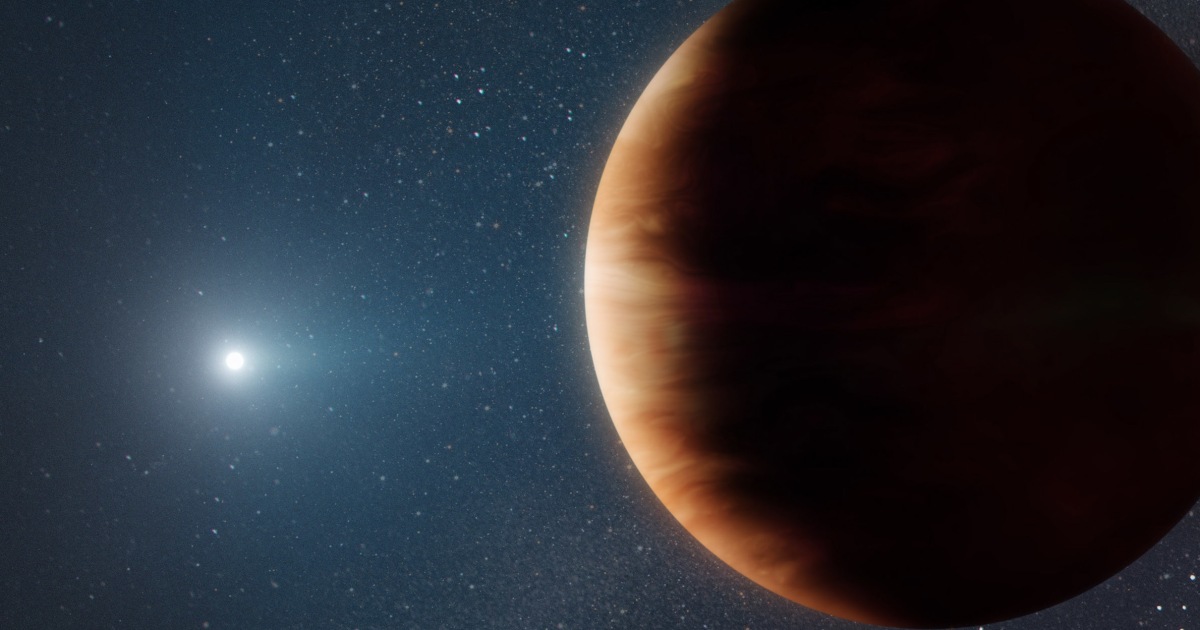
A darkened planet circling the feeble remnant of a burned-out star about 6,000 light-years from Earth shows what our own solar system will look like at the end of its existence, according to astronomers.
The distant survivor, described in a study published last week in the journal Nature, seems to be a gas giant similar to Jupiter and provides a snapshot of a planetary system around a dying star, according to the study’s authors.
The star is now a “white dwarf” — a glimmering stellar remnant left over from the “red giant” phase of its demise, when it expanded tens of thousands of times after using up the hydrogen fuel for its nuclear fusion reactions and then collapsed a few hundred million years later.
Any planets closer to the star are likely to have been destroyed — and the same fate is likely to befall our own world when the sun burns up all of its hydrogen after another 5 billion years or so.
“When the sun balloons outwards in what’s known as its red giant phase, it will likely obliterate Mercury and Venus, and possibly Earth,” said Joshua Blackman, an astronomer at the University of Tasmania in Australia and the lead author of the new study.
The sun will have grown too hot for anything on Earth to survive well before then, and its red giant phase will cause lakes of lava, broken continents and devastating blasts of intense ionizing radiation — if it doesn’t fragment our planet entirely, he said in an email.
But it’s not all bad news: Mars and the outer gas giants — Jupiter, Saturn, Uranus and Neptune — are expected to survive the sun’s burning-out. And now the detection of the distant planet orbiting a white dwarf strengthens that idea.
“Our discovery is evidence that the standard picture of how planetary systems evolve as their host star dies is likely to be correct,” Blackman said.
The newly found white dwarf was detected toward the center of our galaxy by a gravitational effect called “microlensing” as it passed in front of an even farther star.
The gravity of the white dwarf caused the distant star to appear to grow brighter for a few years — a brief flash in astronomical time — as its mass focused light through gravitational lensing, said Jean-Phillippe Beaulieu of the Institut d’Astrophysique de Paris, who led the research and is a co-author of the new study. A second flash of light revealed the orbiting planet.
In fact, it’s only due to microlensing that the white dwarf system has been detected at all. Although the team tried to observe it with the giant telescopes at the Keck Observatory in Hawaii, it proved too dim to see.
They hope soon to get better results with the James Webb Space Telescope, which is due to launch in December and which will be able to observe the darkened system directly, Beaulieu said.
Blackman said the gas giant is about 1.4 times the mass of Jupiter and orbiting 260 million miles to 600 million miles from the white dwarf.
Although it’s likely to have formed farther from the star than its current orbit, the shrinking of the host star after its red giant phase hadn’t drawn it so close that it fragmented, which has been theorized in some models.
“We think the planet survived the red giant phase of its star’s evolution likely untouched,” he said.
Lisa Kaltenegger, an associate astronomy professor and the director of the Carl Sagan Institute at Cornell University, said the new discovery is further proof that planets can survive the demise of their stars.
Kaltenegger was not involved in the latest research, but she was part of a team that reported the detection of a different giant planet orbiting a white dwarf star late last year — the first one ever seen.
That study, however, showed that the planet completes an entire orbit every 1.4 days — so it’s much closer to the white dwarf than Mercury is to the sun.
Kaltenegger said it had likely formed much farther away, but spiraled inward as the star shrank until it stopped a few million miles away.
Taken together, both discoveries show that outer planets — and perhaps their moons — can survive the demise of their stars, although their final orbits seem to depend on their circumstances, she said.
Although white dwarf remnants don’t produce a lot of light, they do produce enough heat to warm their innermost planets, which implies life could still exist in such a planetary system when its star “dies” in this way — perhaps beneath the icy crusts of the moons of gas giants, like Jupiter’s Europa and Saturn’s Enceladus, she said.
Source: | This article originally belongs to Nbcnews.com










